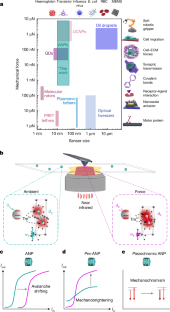2025-01-01 コロンビア大学
<関連情報>
- https://www.engineering.columbia.edu/about/news/tour-de-force-columbia-engineers-discover-new-all-optical-nanoscale-sensors-force
- https://www.nature.com/articles/s41586-024-08221-2
ピコニュートンからマイクロニュートンの力の赤外線ナノセンサー Infrared nanosensors of piconewton to micronewton forces
Natalie Fardian-Melamed,Artiom Skripka,Benedikt Ursprung,Changhwan Lee,Thomas P. Darlington,Ayelet Teitelboim,Xiao Qi,Maoji Wang,Jordan M. Gerton,Bruce E. Cohen,Emory M. Chan & P. James Schuck
Nature Published:01 January 2025
DOI:https://doi.org/10.1038/s41586-024-08221-2

Abstract
Mechanical force is an essential feature for many physical and biological processes1,2,3,4,5,6,7, and remote measurement of mechanical signals with high sensitivity and spatial resolution is needed for diverse applications, including robotics8, biophysics9,10, energy storage11 and medicine12,13. Nanoscale luminescent force sensors excel at measuring piconewton forces, whereas larger sensors have proven powerful in probing micronewton forces14,15,16. However, large gaps remain in the force magnitudes that can be probed remotely from subsurface or interfacial sites, and no individual, non-invasive sensor is capable of measuring over the large dynamic range needed to understand many systems14,17. Here we demonstrate Tm3+-doped avalanching-nanoparticle18 force sensors that can be addressed remotely by deeply penetrating near-infrared light and can detect piconewton to micronewton forces with a dynamic range spanning more than four orders of magnitude. Using atomic force microscopy coupled with single-nanoparticle optical spectroscopy, we characterize the mechanical sensitivity of the photon-avalanching process and reveal its exceptional force responsiveness. By manipulating the Tm3+ concentrations and energy transfer within the nanosensors, we demonstrate different optical force-sensing modalities, including mechanobrightening and mechanochromism. The adaptability of these nanoscale optical force sensors, along with their multiscale-sensing capability, enable operation in the dynamic and versatile environments present in real-world, complex structures spanning biological organisms to nanoelectromechanical systems.



